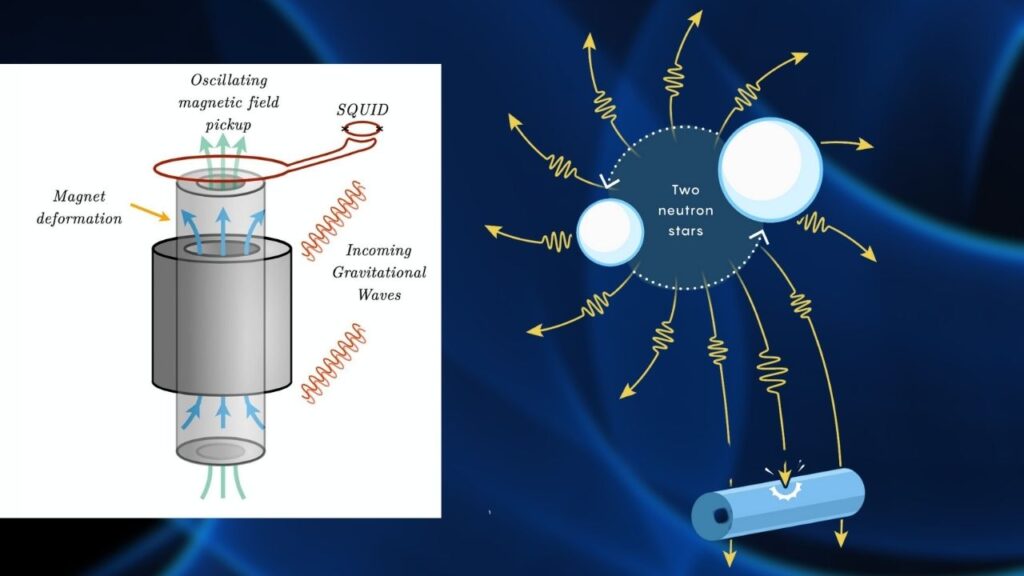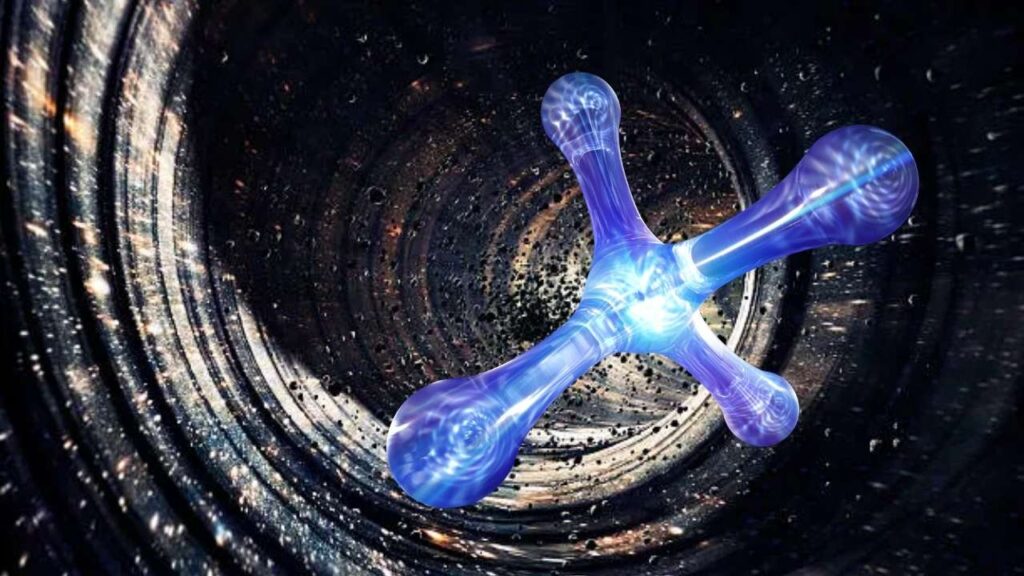Scientists Use Powerful Magnets to Search for High-Frequency Gravitational Waves: Imagine you’re at a pond, and someone throws in a rock. Ripples spread out in circles across the water. In space, something similar happens when big objects—like black holes or neutron stars—crash into each other or spin very fast. Instead of water ripples, these events make ripples in space and time called gravitational waves. Scientists have been trying to “listen” to these waves for decades, and now, thanks to powerful magnets, they might be able to hear much more than ever before.

For years, big machines like LIGO in the USA, Virgo in Italy, and KAGRA in Japan have used lasers and mirrors to catch these ripples. They’ve found more than 200 signals so far, mostly from black holes and neutron stars crashing together. But there’s a problem: these detectors are best at hearing “low notes”—gravitational waves with frequencies around 10 to 6,000 hertz (that’s like the deep sounds of a tuba). What about the “high notes”—ripples much faster, up to a million hertz or more? Until now, those have been almost impossible to detect.
That’s where powerful magnets come in. New research shows that big superconducting magnets, like the ones used to search for dark matter, can act as super-sensitive “ears” for these high-frequency gravitational waves. Scientists are excited because this could open up a whole new way to explore the universe—like turning on a radio and suddenly hearing a new channel no one knew existed.
Scientists Use Powerful Magnets to Search for High-Frequency Gravitational Waves
| Key Point | Details/Stats |
|---|---|
| Current Detectors | LIGO, Virgo, KAGRA: detect 10–6,000 Hz GWs; 200+ events detected |
| New Magnetic Approach | Superconducting magnets detect kilohertz–megahertz GWs |
| High-Frequency GWs | Could reveal exotic physics, dark matter, early universe |
| Career/Professional Insight | Physics, engineering, and astronomy fields expanding due to GW research |
| Next-Gen Detectors | Cosmic Explorer, Einstein Telescope, LISA planned |
The search for gravitational waves is one of the most exciting adventures in science today. With powerful magnets, new lasers, and big plans for the future, scientists are opening up a whole new way to explore the universe. Whether you’re a curious kid or a seasoned professional, there’s never been a better time to learn about these invisible ripples and the amazing technology that lets us “hear” them.
What Are Gravitational Waves? (And Why Should You Care?)
Gravitational waves are ripples in the fabric of space and time, caused by the movement of massive objects like black holes and neutron stars. Think of space as a giant trampoline. If you put a heavy ball (like a black hole) on it and move it around, the trampoline will bend and ripple. Those ripples are like gravitational waves, traveling at the speed of light.
Scientists care about these waves because they give us a new way to “see” the universe. For most of history, we’ve used light (from stars, galaxies, and more) to learn about space. But light can be blocked by dust, gas, or other obstacles. Gravitational waves, on the other hand, go right through everything, letting us peek into the darkest corners of the cosmos.
How Do Scientists Detect Gravitational Waves?
Most detectors today use laser interferometers. These are big machines with long arms (like the 4-kilometer arms of LIGO). When a gravitational wave passes by, it stretches and squeezes space, making the arms change length by a tiny amount—smaller than the width of an atom! Lasers measure these changes and tell scientists a wave has passed.
But these detectors are like listening to only one kind of music—they’re great at low, rumbling sounds but miss the high-pitched notes. That’s a problem because some of the most exciting things in the universe—like tiny black holes, super-dense stars, or even mysterious dark matter—might make gravitational waves at much higher frequencies.
The Power of Magnets: A New Way to Listen
Recently, scientists realized that superconducting magnets—the same kind used in experiments to search for dark matter—could be used to detect high-frequency gravitational waves. Here’s how it works:

- The Old Way: Weber Bars
In the 1960s, Joseph Weber tried to detect gravitational waves using big metal bars. If a wave hit the bar, it would vibrate like a tuning fork. But this only worked if the wave’s frequency matched the bar’s natural “note.” Otherwise, it was like trying to hear a whistle while wearing earmuffs. - The New Way: Magnetic Weber Bars
Now, scientists are using huge magnets filled with superconducting wire. These magnets store a lot of magnetic energy. When a gravitational wave passes through, it jiggles the magnetic field inside, which can be measured very precisely. This lets scientists “tune in” to a much wider range of frequencies—from kilohertz to megahertz—than ever before.
Why Is This a Big Deal?
Detecting high-frequency gravitational waves could help us answer some of the biggest questions in science:
- What is dark matter?
Some theories say dark matter could be made of tiny particles that, if they exist, might leave behind high-frequency gravitational waves.

- What happened in the early universe?
The first moments after the Big Bang might have created ripples at these high frequencies. - Are there new kinds of stars or black holes?
There might be exotic objects out there that we’ve never seen before, and they could be “singing” at these high notes.
Step-by-Step: How the New Magnetic Detectors Work
Let’s break it down into simple steps:
- Superconducting Magnet
A big magnet is cooled to extremely low temperatures so electricity can flow without resistance. This makes the magnet incredibly powerful and stable. - Gravitational Wave Passes Through
When a gravitational wave moves through the magnet, it causes tiny vibrations in the magnetic field. - Detecting the Signal
Sensitive instruments measure these vibrations, turning them into a signal that scientists can analyze. - Analyzing the Data
Scientists look for patterns in the signal that match what they expect from gravitational waves. If they find a match, it could be a new discovery!
What’s Next for Gravitational Wave Science?
Scientists aren’t stopping with magnets. They’re also upgrading existing detectors like GEO600 in Germany to listen for higher-frequency waves. GEO600 is getting a new laser and a faster data system, so it can catch ripples up to a million hertz or more.
There are also plans for even bigger and better detectors, like the Einstein Telescope in Europe and Cosmic Explorer in the USA. These will be more sensitive and able to hear even fainter signals from farther away.
And don’t forget about space! The LISA mission will put detectors in space, where they can listen for low-frequency waves that are hard to hear on Earth.
Quantum Breakthrough: Quantinuum Reaches Critical Milestone in Error Correction
How the Universe’s Basic Building Blocks Exploded Into Existence, According to a Physicist
Most Distant Mini-Halo Ever Observed: Unlocking the Secrets of the Early Universe
FAQs About Scientists Use Powerful Magnets to Search for High-Frequency Gravitational Waves
Q: Why are high-frequency gravitational waves so hard to detect?
A: Most detectors are built to listen to low-frequency waves, like those from big black holes. High-frequency waves are much faster and need special equipment to catch—like the new magnetic detectors.
Q: What can we learn from detecting these waves?
A: High-frequency gravitational waves could tell us about dark matter, the early universe, and new kinds of stars or black holes that we’ve never seen before.
Q: How do magnets help detect gravitational waves?
A: Superconducting magnets store a lot of energy. When a gravitational wave passes through, it shakes the magnetic field, which can be measured very precisely.
Q: Are there other ways to detect gravitational waves?
A: Yes! Most detectors today use lasers and mirrors (interferometers). Some scientists are also looking at using the magnetic fields around planets to turn gravitational waves into light, which can be detected by telescopes.
Q: What careers are involved in this research?
A: Physicists, engineers, astronomers, and computer scientists all work together to build and operate these detectors and analyze the data.






